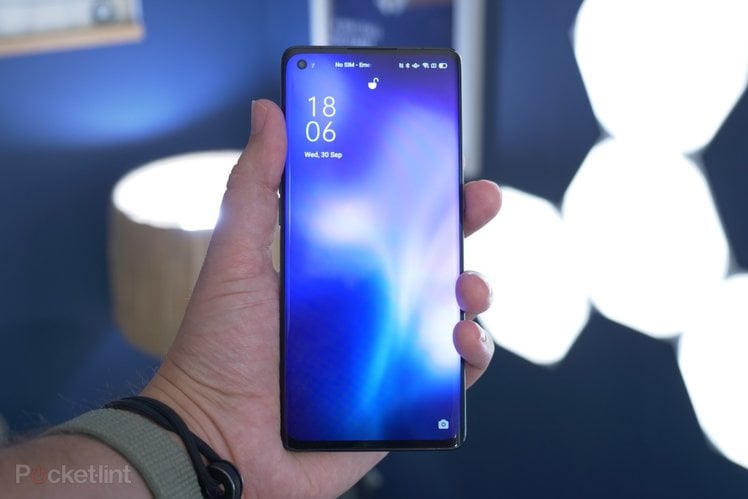
It doesn’t seem all that long ago that Oppo launched its first Reno-branded phones, and yet we’re now onto the fourth generation already. The Reno 4 series – in the UK at least – is divided up into three models: Reno 4, Reno 4 Pro and Reno 4 Z, and they’re all designed to hit specific price points.
Of the three, it’s unsurprisingly the Pro model that’s pitched as the more premium model. It’s the most expensive, but also has the most finesse and the more impressive spec sheet. In fact, it’s got a lot of what you’d expect to see in an ultra-premium device. Bar one or two things, it has everything you could need, so is the price justified? Read on to find out.
Classy and sleek looks
- 159.6 x 72.5 x 7.6 mm
- Weighs just 172 grams
- All glass front and back
- Monogrammed design on Space Black model
When 5G phones first hit the scenes – and just like when 4G became a thing – phones were pretty large. Not only did phones need an extra external chip to act as the modem, but space was required for cooling, while larger batteries were required to keep the phones going all day.
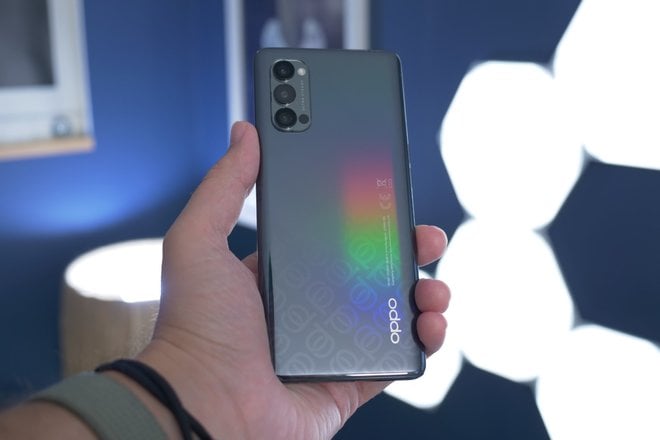
For 2020, however – and with the advancement of processors that have built-in 5G modems – phones don’t have to be as large. Samsung showed it with the S20, and Oppo has shown it first with the Find X2 Neo, and now with the Reno 4 Pro. It’s an impressively slim and sleek device.
In fact, it’s very similar to the Find X2 Neo in terms of size, shape and build. It’s got the glass on the front and back that curves towards the edges, making it look and feel really slim. It’s narrow too and has really skinny bezels on the front, ensuring the screen takes up around 94 per cent of the available space.
Where it differs is in the styling and finish of that rear panel. There’s a new Arctic Blue model that features a frosted glass finish, but unlike most other frosted glass phones, this has been created using an Oppo-designed technique of creating microscopic laser etchings along the surface. This way it resists scratches and fingerprint smudges.
We were sent the Space Black model which has a much more traditional black, glossy look. However, even that’s a bit unique. There’s a rainbow effect that appears when you angle it towards light, as well as a pattern of repeating monograms spelling out ‘OP’. Because Oppo.
The company says this is to make the phone something of a fashion statement. We feel you’ll either love it or hate it. Opinions are definitely mixed here at Pocket-lint.
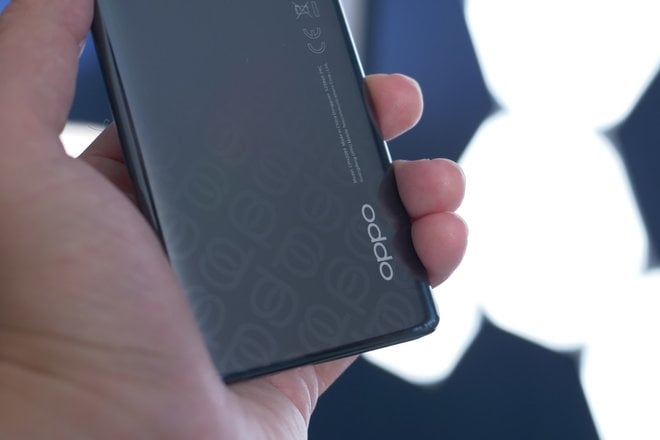
The camera housing is among one of the most attractive we’ve seen on any smartphone to date. It’s a simple, glossy rectangle with rounded corners that protrudes from the back with three identically sized camera rings in a neat row. It’s compact, and pleasant to look at.
To pick up and hold it in the hand, it’s just a delight. Some of the rough edges we found between the glass and metal – where it wasn’t quite seamless – on the Find X2 Neo seem to be gone. This is one slim, smooth and sumptuous mid-ranger. As phones go, it’s one of the nicest to look at and one of the nicest to hold in any price bracket.
Display
- 6.5-inch AMOLED display
- FHD+ 1080 x 2400
- 90Hz refresh rate
- Single cutout for selfie camera
The screen on Oppo’s latest top mid-range phone is based on AMOLED tech, and that means you get all the benefits you’d expect. It’s bright (at about 500 nits peak brightness), and features deep inky blacks and vibrant colours. It also has the added bonus of 90Hz refresh rates, and that means animations when scrolling should stay sharp and smooth when you’re switching between areas in the general user interface or scrolling up and down menus like the app drawer or settings app.
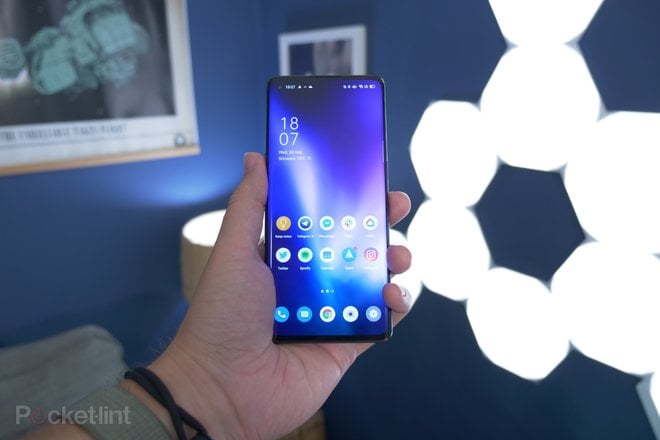
On first impressions, it seems sharp and vibrant. We immediately loaded one of Oppo’s excellent live wallpapers on to it and were pleased to find it gliding and shifting smoothly under the surface of the glass.
While it’s not as sharp as a Quad HD display on something like the Galaxy S20, but it doesn’t appear to be lacking in sharpness. Being around 400 pixels-per-inch, it’s still virtually impossible to see any individual pixels.
Of course, we’ll need to test it further to bring you our full thoughts on it. After a few days though, we can say we’ve got no complaints so far.
All about speed
- Snapdragon 765G processor (5G support)
- 12GB RAM
- 256GB storage
- 4,000mAh battery + 65W Super VOOC 2.0 charging
Look at the 2020 mid-range market and you’ll see one familiar site: a Snapdragon 700-series processor. In this case, it’s the same 765G chip that’s inside the OnePlus Nord and a handful of other powerful mid-rangers. It’s not quite an 800-series, but in our experience with it so far, it’s not far off.
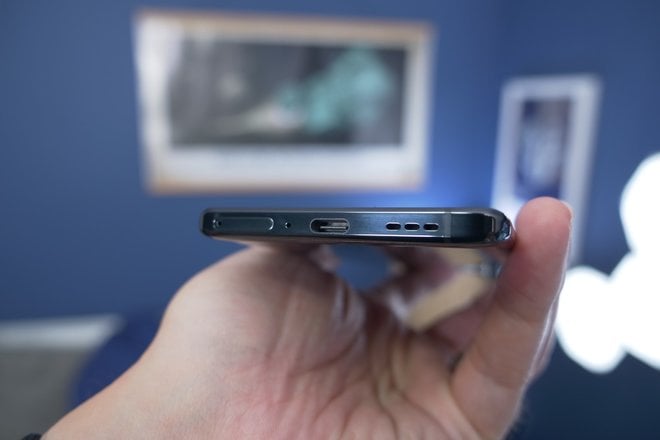
Joining it, there’s a generous 12GB RAM and 256GB storage in the UK variant, and that is more than enough to keep the most demanding apps running smoothly and ensure you have enough space to store all of your photos, music and video for entertainment on the go.
The 4,000mAh battery is about standard in terms of capacity these days, but what’s not standard is Oppo’s Super VOOC 2.0 flash charging technology. This particular flavour is the 65W variant we’ve seen on top tier phones like the Find X2 Pro. With an empty battery, it’ll charge from 0-66 per cent in just 15 minutes and finish its charge completely in 35 minutes. Whoo, that’s fast!
What we’ve found in the past with phones using this tech is that it changes your charging behaviour as a user. You no longer have to charge it overnight. You can wait until it runs flat, plug it in, and even 10-15 minutes plugged in is enough to get you through the rest of the day.
A note on cameras
- Triple camera on the back
- 48MP primary camera
- 12MP ultra-wide ‘night’ camera
- 13MP 5x hybrid zoom telephoto
- Single 32MP selfie camera on the front
- Ultra night mode video shooting
One thing we like about this particular mid-ranger is that its cameras are all actually useful. It’s not a quad-camera system with additional lenses just to brag about its cameras on a spec sheet. Instead, Oppo went with three different, useable focal lengths and added in some AI smarts to boost night-time performance and video stability.
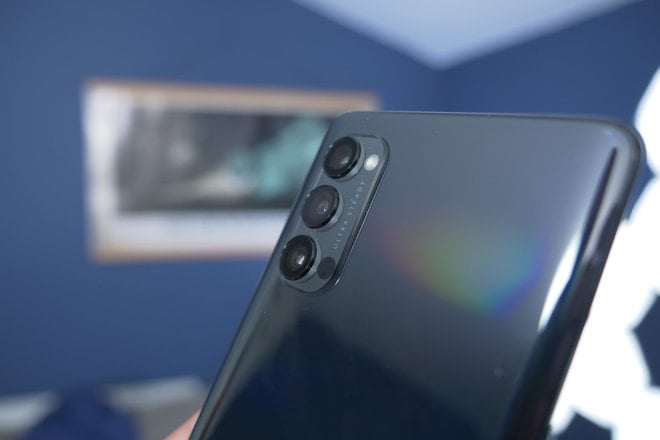
The 48-megapixel main camera is joined by a 12-megapixel ultra-wide camera and a 13-megapixel telephoto lens. What’s interesting here is that the 12-megapixel ultra-wide is also being branded as a ‘night’ camera. A lot of that is down to the fact that Oppo has boosted its night performance, especially when shooting video.
As for that third lens, that’s a 5x hybrid zoom camera, so while it’s not quite as impressive as the high-end periscope-like lenses that go up to twice that, it’s still a very versatile system, at least, it seems it. We still need to test these out to see how they actually perform.
Other features worth noting on the camera front are the fact that Oppo has built-in ‘ultra steady’ video capabilities, letting you shoot with the front or back cameras while stabilising the footage to make it smooth. Plus, there’s natural bokeh for background blur, laser detection autofocus and HDR videos that even out extreme contrasting highlights and shadows to retain detail and colour.
